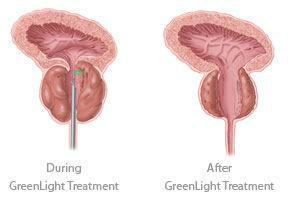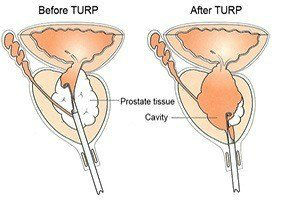Prostate Enlargement Benign Prostatic Hyperplasia (BPH)
Benign prostatic hyperplasia (BPH) or benign prostatic hypertrophy is enlargement of the prostate gland. The word “benign” means the cells are not cancerous. “Hyperplasia” means an increased number of cells.
It is common for the prostate gland to become enlarged as a man ages. Though the prostate continues to grow during most of a man’s life, the enlargement doesn’t usually cause problems until late in life. BPH rarely causes symptoms before age 40, but more than half of men in their sixties and as many as 90 percent in their seventies and eighties have some symptoms of BPH.
The prostate gland encircles the urethra, so problems with urination can occur if the gland restricts urine flow through the tube. As the prostate enlarges, the layer of tissue surrounding it stops it from expanding, causing the gland to press against the urethra like a clamp on a garden hose.
The following changes occur over a period of time.
- The bladder wall becomes thicker and irritable
- The bladder begins to contract even when it contains small amounts of urine, causing more frequent urination
- Eventually, the bladder weakens and loses the ability to empty itself. Urine remains in the bladder
The narrowing of the urethra and partial emptying of the bladder cause many of the problems associated with BPH.
Some problems associated with BPH are
- Urinating more often during the day
- Need to urinate frequently during the night
- Urinary urgency, which means the urge to urinate is so strong and sudden, you may not make it to the toilet in time
- The urine stream is slow to start
- Urine dribbling sometime after finishing urination
- A sensation that the bladder isn’t fully emptied after urination
- Lack of force to the urine flow, which makes aiming more difficult
- The sensation of needing to go again a few minutes after urinating
Work-up:
After a thorough clinical evaluation, A/Prof Katz have some of the latest diagnostic equipment on site, such as urine flow meters and a bladder and prostate ultrasound machine, which can help to accurately diagnose your condition and plan your personalised management.
Treatments:
Non-Surgical Treatments:
Specialists at MHM prefer to treat you prostate or bladder problems with a conservative approach if possible and thereby avoiding surgery.
Possible conservative treatments which may be used include:
- Fluid management strategies
- Adjustment of your current medications
- Starting new Prostate/Bladder directed medications
- Specialist men’s health physiotherapy
Surgical Treatments:
If after conservative treatments have failed or are deemed not to be advantageous, then we will discuss with you if surgery is indicated.
A/Prof Katz offer a variety of procedures for the prostate. The procedure which is best suited to you will be determined based on your comprehensive clinical assessment and investigations.
Some of the more common procedures we offer are:
Greenlight Laser Prostate Surgery:

- Laser surgery is one of the latest advances in BPH (Benign Prostatic Hyperplasia) management.
- There is minimal blood loss.
- It can be performed in most men even if they are taking blood thinning medications.
- Most patients can be discharged the next day after their laser treatment.
![]() Click here to know more about Green Light Laser Therapy
Click here to know more about Green Light Laser Therapy
Urolift Procedure:

- This is the newest procedure approved for BPH
- It has the benefits of causing minimal bleeding and does not cause sexual side effects
- Most patients can be discharged the same day without a catheter
- For more information on the Urolift procedure, please click here to see this video
Transurethral Incision of the Prostate (TUIP):
- TUIP is a minimally invasive procedure for men who have urination problems and have a small prostate.
- The operation takes about 10 mins and can significantly improve a patient’s symptoms.
- TUIP is also useful for patients that need surgery but are keen to avoid ejaculation problems.
Transurethral Resection of the Prostate (TURP):

- TURP is the gold standard operation for BPH.
- The procedure was first developed in the 1930’s and has undergone many refinements over this period.
- It is still one of the most commonly performed procedures in Australia for BPH and has excellent long term results.
- A TURP is often indicated in patients for which the Green light Laser or the TUIP is not suitable.
You will need the Adobe Reader to view and print these documents.![]()
 Minimally Invasive Prostate Surgery
Minimally Invasive Prostate Surgery Penile Implant Surgery
Penile Implant Surgery Kidney Stones
Kidney Stones Male Fertility Check-Up
Male Fertility Check-Up Microsurgery for Male infertility and Vasectomy Reversal
Microsurgery for Male infertility and Vasectomy Reversal Incontinence
Incontinence Erectile Dysfunction
Erectile Dysfunction General Urological Conditions
General Urological Conditions Peyronie’s Disease
Peyronie’s Disease Penile Duplex Doppler Ultrasound
Penile Duplex Doppler Ultrasound Penile Rehabilitation
Penile Rehabilitation Testosterone Therapies
Testosterone Therapies Premature Ejaculation
Premature Ejaculation









 A/Prof Darren Katz
A/Prof Darren Katz Dr. Deanne Soares
Dr. Deanne Soares Dr. Vincent Chan
Dr. Vincent Chan Dr. Glenn Duns
Dr. Glenn Duns Luke Mitchell
Luke Mitchell






